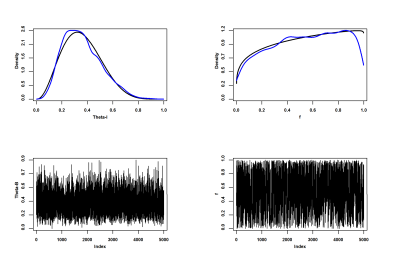hickory
Table of Contents
HICKORY
version 1.1
Software for analysis of geographic structure in genetic data. The software implements the Bayesian method described in Holsinger (1999) for estimating F-statistics co-dominant marker data and the method described in Holsinger et al. (2002) for estimating F-statistics from dominant marker data. It also includes routines to allow posterior comparisons as described in Holsinger and Wallace (2004).
Program information
- Windows
- Linux
Data type handled
- dominant markers
- co-dominant markers
- AFLP (amplified fragment length polymorphism)
- RAPD (random amplified polymorphic DNA)
- multi-allelic markers
Input Files
files in NEXUS format
- need only an alleles block:
#nexus begin alleles; [comments are surrounded by square brackets] dimensions newpops npops=2 nloci=3; format labels missing=? separator=/; locusallelelabels 1 ’pgi 1’, 2 ’pgi 2’, 3 adh; matrix Embudo: indiv_1 A/A 100/110 slow/fast indiv_2 A/A 75 / 90 slow/slow indiv_3 A/a 75/100 fast/slow indiv_4 A/A 100/100 fast/fast, Black_Mesa: 1 a/a 110/100 fast/slow 2 a/A 75/100 slow/slow 3 a/a 100/100 fast/fast ; end;
- dimensions command:
- nloci: number of loci scored
- npops: number of populations scored
- format command:
- missing: character to be used for missing data (missing diploid genotype would thus be specified as ?/?)
- locusallelelabels command:
- optional (loci will simply be numbered)
- comma-separated list of locus number and locus name pairs
- matrix command:
- The genotype for a diploid locus at a co-dominant locus takes the form A/a
- forward slash (/) symbol serves as a separator symbol, making it clear which pairs of alleles belong to each locus
- If the loci represent dominant genetic markers, do not use the slash and specify only one allele for each locus
- phenotype for a dominant locus (dominant marker):
- keyword
dominant - dominant phenotype is scored as
1(or+) or0(−) (default) - Hickory accepts the following alternatives:
dominant; -> default dominant all:1; -> default dominant all:0; -> dominant phenotype at all loci scored as 0 (recessive = 1) dominant 1,2,3:1 4,5:0; -> dominant phenotype at first 3 loci scored as 1 and at last 2 loci scored as 0 dominant 1-3:1 4-5:0; -> dominant phenotype at first 3 loci scored as 1 and at last 2 loci scored as 0
- the hickory block is optional:
- you can set parameters governing the MCMC sampler
How to cite
- Holsinger, K. E. 1999. Analysis of genetic diversity in geographically structured populations: a Bayesian perspective. Hereditas 130:245-255.
- Holsinger, K. E., P. O. Lewis, and D. K. Dey. 2002. A Bayesian approach to inferring population structure from dominant markers. Molecular Ecology 11:1157-1164.
- Holsinger, K. E., and L. E. Wallace. 2004. Bayesian approaches for the analysis of population structure: an example from Platanthera leucophaea (Orchidaceae). Molecular Ecology 13:887-894.
- Song, S., D. K. Dey, and K. E. Holsinger. 2006. Differentiation among populations with migration, mutation, and drift: implications for genetic inference. Evolution 60:1-12.
hickory.txt · Last modified: 2008/07/22 13:31 by 127.0.0.1

